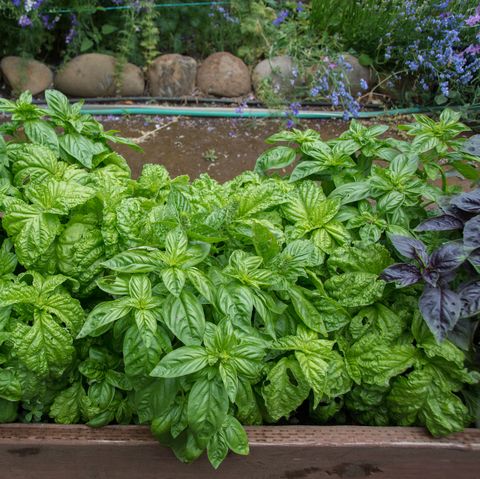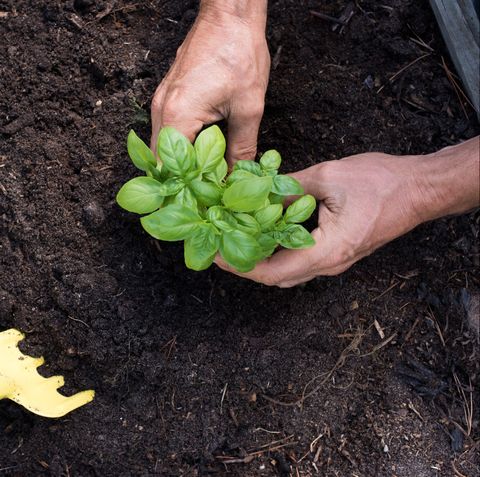It's Time to Start Growing Basil Because What Else Do You Have to Do
Of all the herbs, basil is most likely to be crowned prom queen.
Basil has charisma. Basil carries an alluring perfume and a kind, gentle demeanor. And if you judge an herb by the company it keeps, well, basil is often seen hanging out with pizza.
But for all of basil’s understandable popularity, it is also flighty.
Fresh basil (note that we’re not talking about the skunky-tasting stuff in the shaker here) is only ever really in season during the summer months.

Subscribe to Men’s Health
SHOP NOW
Yes, you can buy hydroponic basil or basil plants in the grocery store year-round, and while that basil is way better-tasting than dried basil, it still pales in comparison to basil you grow yourself.
Because basil you grow yourself tastes not only of deliciousness, but also of victory.
Here’s everything you need to know to get a taste.
You can’t go wrong with whichever variety of basil you buy.

Barbara Rich
Basil Genovese is the basil you’re used to from the grocery store. This variety has large, plump, dome-shaped leaves. It’s excellent for pizza and pesto.
Lemon basil, by comparison, has leaves that are tapered and pointed. It’s a hardy variety, which means its great for beginners and, true to its name, carries a slightly tart taste. It’s great cut into thin ribbons and thrown into a seafood-based pasta dish just before serving.
Purple basil is similar to basil Genovese in the shape of its leaves, but, yes, those leaves are indigo in color. The flavor is somewhat similar, too, but purple pesto always comes out looking a little greenish-brown, which isn’t always super appetizing. This stuff is better suited for flavoring homemade salad dressings.
There’s also Thai basil and lettuce basil and cinnamon basil and a bunch more, but the three basils listed above—Genovese, lemon, and purple—are the most versatile. That means you’ll use what you grow.
Growing basil is way easier than you think.

Ridofranz
While you can start basil from seed—and it’s fun to watch those little suckers spring forth from the soil—you’re better off just buying transplants and popping them in some dirt.
And, seriously, that’s about all you have to do.
If you’re planting your basil indoors, just do so in a large pot with a hole in the bottom for drainage (or you can always drill one). Stick a plate under the pot to prevent overflow spills.

6″ Certamic Footed Planter
Project 62
target.com
$10.20
SHOP NOW
Fill the pot with potting soil; dig just deep enough so that your mini-basil plant sits flush with the surface soil after you’ve stuck it in there and returned the dirt.
Then place your plant somewhere where it’ll bask in sun for about six hours out of the day and the temperature doesn’t ever dip below 50°F, according to Penn State. Otherwise that basil is going to wither and die on you.
If you’re planting your basil outside, just make sure to follow that 50°F rule. And, if you’re planting a few basil plants, make sure to distance each plant about a foot apart. Depending on the variety, basil plants can grow large (for an herb) and you don’t want the plants competing for space and nutrients.
Water the basil when the soil starts to feel dry. Sing sexy songs to it. Tend to it lovingly. Because it will soon reward you for your efforts.
Harvesting basil is also incredibly easy.
You seeing a trend here?
You can harvest basil at any time, but, as a general rule, try not to harvest any more than 25 percent of the plant in one go. This way, your basil will grow lush and full.
Using a pair of scissors or, hell, your fingers, pluck the leaves from the top part of the plant to harvest. And, while you’re at it, pick off any yellowish leaves hanging around the bottom. You also don’t want the basil to begin flowering. Although basil flowers are in themselves flavorful, allowing them to flourish can turn the basil leaves bitter.
Eating basil is the easiest part.

Westend61
Pizza. Pesto. Pasta. Caprese salad. Salad dressing. Thrown straight into salad. Stir-fry. Cocktails. Mocktails. Scrambled into eggs. As a burger topping. As a hot dog topping. Blended into gazpacho. Blended into a greens shake. Scattered atop grilled salmon. Strung in a garland around your neck and nibbled at when needed. This stuff is amazing for just about everything.
Storing basil can be a teeny bit tricky.
Yup, there’s a catch. Basil doesn’t have what you might call an “incredible shelf-life.” It’s actually pretty poor. Okay, it sucks. Basil can quickly turn brown and slimy if you aren’t careful.
Here’s your best bet: If you picked more basil than you should have, arrange the extra leaves on a damp (not wet) paper towel. Roll everything up and place it in a plastic bag and throw the bag in the fridge. You’ll get a few more (delicious) days out of them.
Source: Read Full Article
